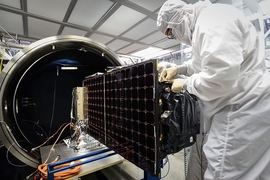The longest continuously operating communications satellite in U.S. history, Lincoln Experimental Satellite–9 (LES-9), was decommissioned by MIT Lincoln Laboratory on May 20. The LES research team has been monitoring the satellite since it was launched in 1976. The gradual reduction in available power, coupled with the loss of the primary S-band telemetry data in early 2020, led to the decision to retire the satellite.
“The Lincoln Experimental Satellite program was a monumental technical achievement and created the architectural framework and technology foundation that has enabled the nation’s military satellite communications systems,” says David McElroy of Lincoln Laboratory's Communication Systems Division, who has been the principal researcher on many of the laboratory's satellite communications (SATCOM) programs. LES-9 was the last and most technically sophisticated of the systems developed under the LES program that ran from the early 1960s until the late 1970s. “This satellite demonstrated the path forward for reliable communications among mobile users and for an expansion into very wideband RF SATCOM systems,” he adds.
For the LES-9 effort, the laboratory was tasked by the U.S. Department of Defense to develop an architectural concept and enabling technologies to vastly enhance the robustness of long-range, wide-area communication links among strategic command authorities and to/from their mobile forces. The program was a response to national studies that had identified emerging Cold War-era threats that could jeopardize the connectivity of U.S. communication systems operating in remote areas. In addition, the existing 1960s systems lacked the bandwidth to support the data rates that mobile users would need to accommodate newly evolving video services and sensor information.
The LES-9 vehicle was launched in 1976 along with a “sister” satellite, LES-8. These two systems demonstrated the first use of several innovative concepts and technologies:
- Ka band for very wide bandwidths;
- extremely wideband, very-fast, frequency-hopping, interference-mitigation spread-spectrum techniques;
- onboard digital processing and routing for the rejection of uplink interference and for effective use of satellite resources;
- a new code-division multiple-access technique to allow a large number of asynchronous, bursty-traffic users to efficiently utilize bandwidth for low duty cycle messages; and
- intersatellite links enabling extremely long-range connectivity without multiple ground relay “hops” that would lead to signal delays and potential physical relay-site vulnerabilities.
The LES team also designed innovative human-interface control panels that allowed LES-8/9 communications configurations to be rapidly established or changed without requiring staff to have extensive knowledge of the satellite’s design. The viability of controlling a strategic communications scenario from an airborne command post was demonstrated by connecting the LES control panels to terminals on an Air Force Research Laboratory test aircraft and executing force-direction, command conferencing, and report-back functions while the controlling aircraft flew in the Arctic.
The successful 1976 LES-8/9 demonstrations showed that the systems' advanced technologies were ready for use in space environments. Since then, generations of military satellite communication systems have employed techniques pioneered in LES-8/9.
“The development of modern military systems, such as the Milstar and Advanced Extremely High Frequency systems, has benefited from the technical expertise Lincoln Laboratory gained by operating LES-9 in a realistic environment,” says Thomas Macdonald, assistant head of the Communication Systems Division. “While LES-9's spread-spectrum technologies were primarily of interest for military systems, the other game-changing LES-9 technologies influenced nonmilitary SATCOM systems, such as NASA’s Advanced Communications Technology Satellite program in 1993,” Macdonald adds.
Not only did the 1976 LES-9 demonstration empower new generations of advanced SATCOM systems, but LES-9 itself continued to provide decades of reliable communications for a diverse set of applications including the alignment of radio astronomy antennas, geolocation of transmitters, RF connectivity with remote northern and southern regions, and educational outreach activities by serving as a test platform for student-developed software radios. During the summer of 1994, LES-9 supported a U.S. Coast Guard voyage over the North Pole. For years, the National Science Foundation scheduled daily access time on LES-9 for connectivity to their personnel stationed in Antarctica.
“This satellite carried much of the critical email traffic between the continental United States and the South Pole for the long-distance medical treatment of Dr. Jerri Nielsen, prior to seasonal conditions improving so that she could be evacuated from the Antarctic station on Oct. 15, 1999,” McElroy notes.
For 28 years, LES-8 joined its partner in performing validating architectural concept and technology-maturity demonstrations, as well as a broad portfolio of services. In 2004, the functioning of LES-8’s command system became intermittent and the satellite was decommissioned.








